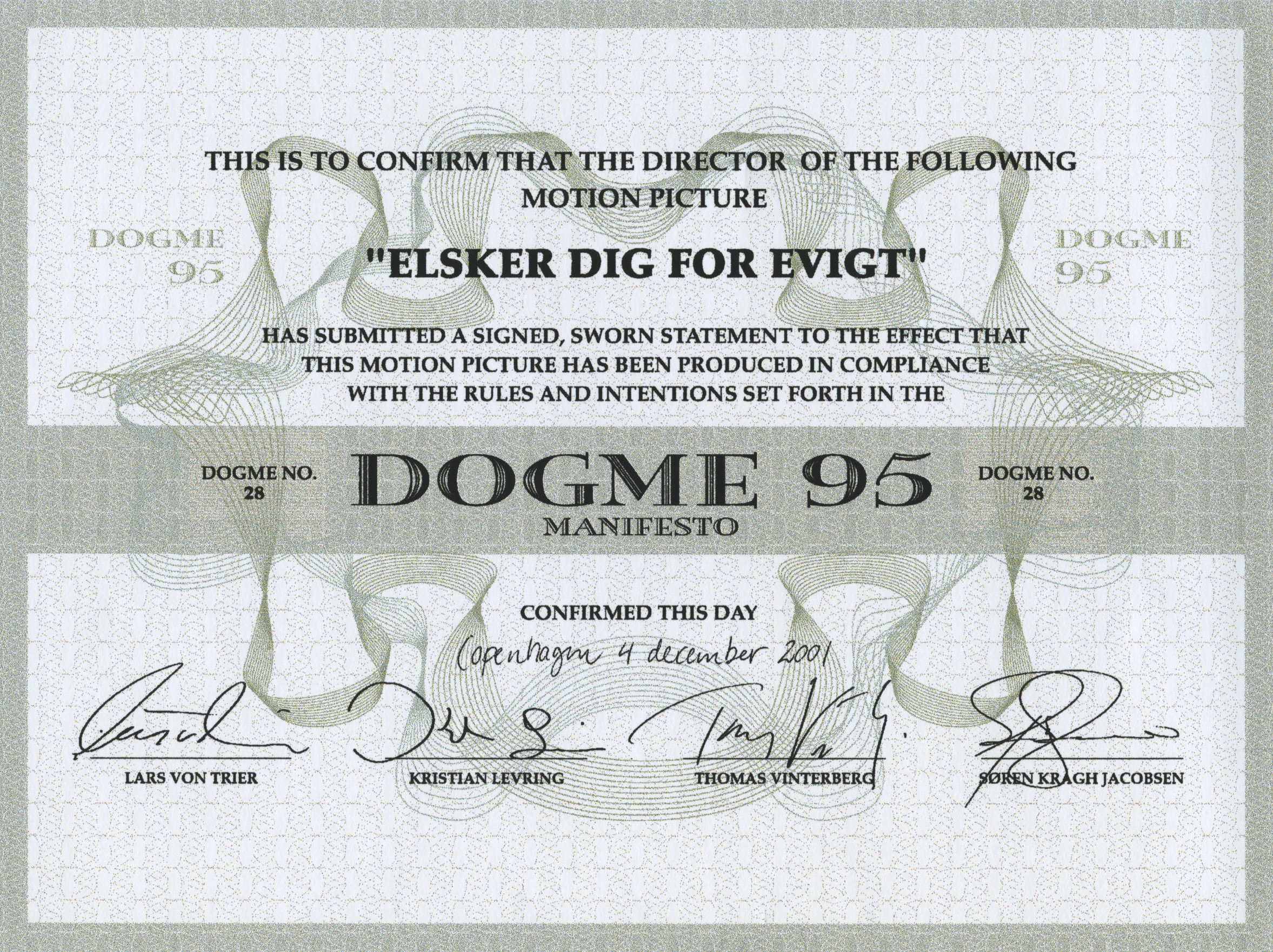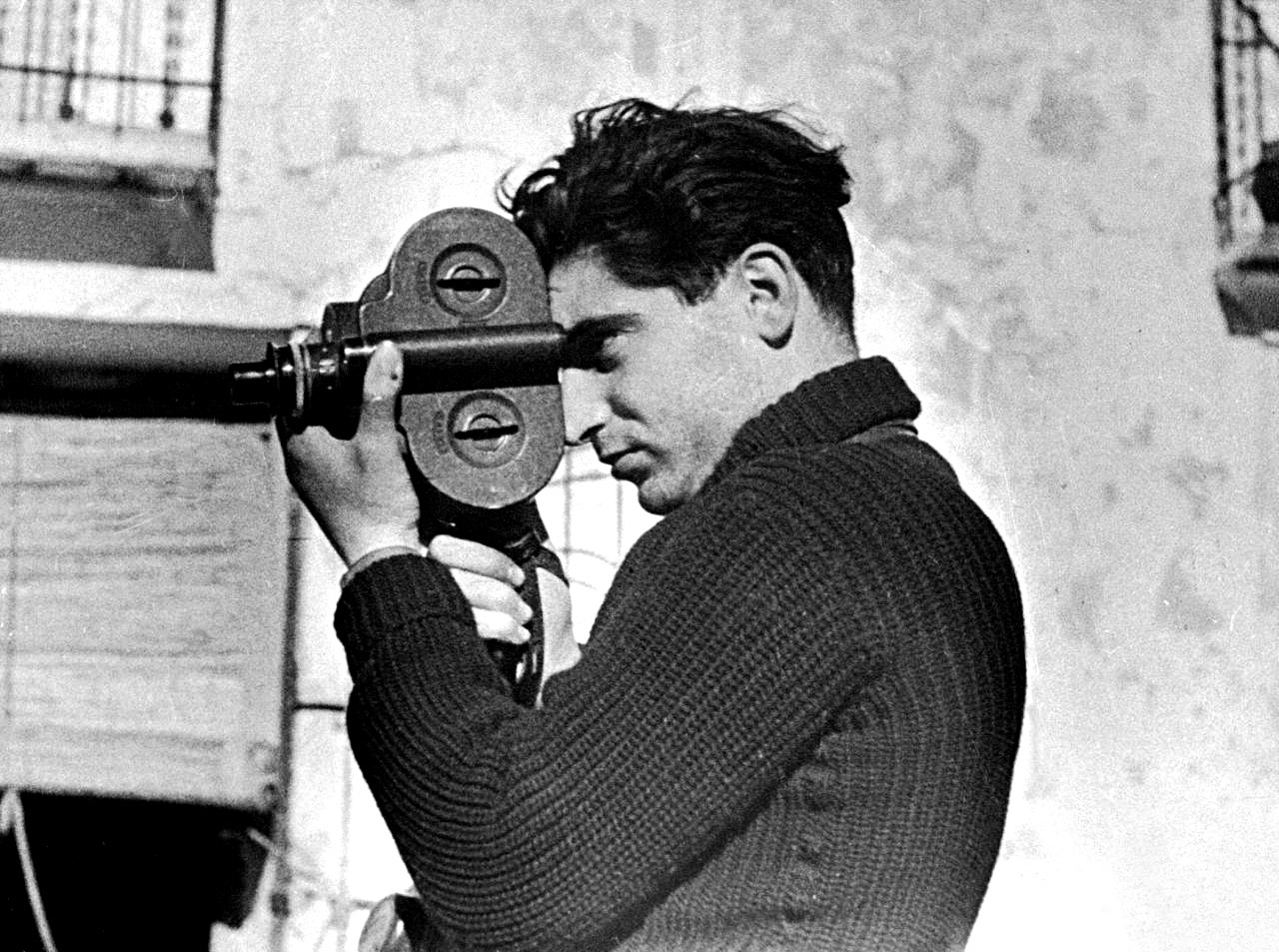|
Automavision
Automavision is a cinematic technique invented by Danish director Lars von Trier. Developed with the intention of limiting human influence, in Automavision no cinematographer is actively operating the camera. The best possible fixed camera position is chosen and then a computer chooses framing by randomly tilting, panning or zooming the camera. In doing so it is not uncommon that the actors appear in the shots with a part of their face and head cut from the frame. With this technique then the blame for any "errors" are entirely attributable to a computer. Von Trier described Automavision as "a principle for shooting film developed with the intention of limiting human influence by inviting chance in from the cold (...) and thus giving the work an idea-less surface free of the force of habit and aesthetics." The principle was used during filming of the movie '' The Boss of It All'' (2006). Interviewed by ''The Guardian'' in 2006, von Trier said, "For a long time, my films have b ... [...More Info...] [...Related Items...] OR: [Wikipedia] [Google] [Baidu] |
The Boss Of It All
''The Boss of It All'' ( da, Direktøren for det hele) is a 2006 experimental comedy film written and directed by Lars von Trier. The film uses a cinematic technique invented by von Trier himself called Automavision, which automatically determines framing by randomly tilting, panning or zooming the camera without being actively operated by the cinematographer. Plot The owner of an IT company, Ravn, wishes to sell it. But, for years, he has pretended that the real boss lives in America and communicates with the staff only by e-mail. That way, all the unpopular decisions can be attributed to the absentee manager, while all the popular ones to him directly. But now, the prospective buyer insists on meeting the big boss in person. In a panic, the owner hires a failed, over-intellectualizing actor to portray this imaginary boss, and the actor proceeds to improvise all his lines, to the consternation of both the buyer and the company staff, who finally get to meet their ghostly bo ... [...More Info...] [...Related Items...] OR: [Wikipedia] [Google] [Baidu] |
Lars Von Trier
Lars von Trier (''né'' Trier; 30 April 1956) is a Danish filmmaker, actor, and lyricist. Having garnered a reputation as a highly ambitious, polarizing filmmaker, he has been the subject of several controversies: Cannes Film Festival, Cannes, in addition to nominating and awarding his films on numerous occasions, once listed him as ''persona non grata'' for flippant Nazism, Nazi remarks during an interview; depictions of graphic violence and unsimulated sex in some of his films have drawn criticism; and he has been accused of mistreating actresses during filming, including Björk and Nicole Kidman. Trier's career has spanned more than four decades and his works have gained notoriety for his trademarks including European frequent actors (particularly Jean-Marc Barr, Udo Kier and Stellan Skarsgård), different thematic Trilogy, trilogies, Hand-held camera, handheld camerawork, upsetting subject matters, genre and technical innovation, confrontational examination of existentialism ... [...More Info...] [...Related Items...] OR: [Wikipedia] [Google] [Baidu] |
Cinematic Techniques
This article contains a list of cinematic techniques that are divided into categories and briefly described. Basic definitions of terms ; 180-degree rule :A continuity editorial technique in which sequential shots of two or more actors within a scene are all shot with the camera on one side of the two actors so that a coherent spatial relationship and eyeline match are maintained. ;Airborne shot :A shot taken from an aerial device, generally while moving. This technique has gained popularity in recent years due to the popularity and growing availability of drones. ;Arc :A dolly shot where the camera moves in an arc along a circular or elliptical radius in relation to the subject ("arc left" or "arc right") ; Backlighting (lighting design) :The main source of light is behind the subject, silhouetting it, and directed toward the camera. ;Bridging shot :A shot used to cover a jump in time or place or other discontinuity. Examples are a clock face showing advancing time, falling ... [...More Info...] [...Related Items...] OR: [Wikipedia] [Google] [Baidu] |
Cinematographer
The cinematographer or director of photography (sometimes shortened to DP or DOP) is the person responsible for the photographing or recording of a film, television production, music video or other live action piece. The cinematographer is the chief of the camera and light crews working on such projects and would normally be responsible for making artistic and technical decisions related to the image and for selecting the camera, film stock, lenses, filters, etc. The study and practice of this field is referred to as cinematography. The cinematographer is a subordinate of the director, tasked with capturing a scene in accordance with director’s vision. Relations between the cinematographer and director vary. In some instances, the director will allow the cinematographer complete independence, while in others, the director allows little to none, even going so far as to specify exact camera placement and lens selection. Such a level of involvement is less common when the direc ... [...More Info...] [...Related Items...] OR: [Wikipedia] [Google] [Baidu] |
Camera Angle
The camera angle marks the specific location at which the movie camera or video camera is placed to take a shot. A scene may be shot from several camera angles simultaneously. This will give a different experience and sometimes emotion. The different camera angles will have different effects on the viewer and how they perceive the scene that is shot. There are a few different routes that a camera operator could take to achieve this effect. Angles and their impact Where the camera is placed in relation to the subject can affect the way the viewer perceives the subject. There are a number of camera angles, such as a high-angle shot, a low-angle shot, a bird's-eye view and a worm's-eye view. A viewpoint is the apparent distance and angle from which the camera views and records the subject. They also include the eye-level camera angle, the over the shoulder shot and the point of view shot. A high-angle shot (HA) is a shot in which the camera is physically higher than the s ... [...More Info...] [...Related Items...] OR: [Wikipedia] [Google] [Baidu] |
Framing (visual Arts)
In visual arts and particularly cinematography, framing is the presentation of visual elements in an image, especially the placement of the subject in relation to other objects. Framing can make an image more aesthetics, aesthetically pleasing and keep the viewer's attention, focus on the framed object(s). It can also be used as a repoussoir, to direct attention back into the scene. It can add :wikt:depth, depth to an image, and can add interest to the picture when the frame is thematically related to the object being framed. Purpose The goal is often to focus the viewer's attention upon the subject, but the ends and means are ultimately at the discretion of the artist. It is accomplished by manipulating the viewpoint of the image, rather than the object(s) within. Framing, especially in the photographic arts, is primarily concerned with the position and perspective of the viewer. The position of the observer has tremendous impact on their perception of the main subject, both ... [...More Info...] [...Related Items...] OR: [Wikipedia] [Google] [Baidu] |
Tilt (camera)
Tilting is a cinematographic technique in which the camera stays in a fixed position but rotates up/down in a vertical plane. Tilting the camera results in a motion similar to someone raising or lowering their head to look up or down. It is distinguished from panning in which the camera is horizontally pivoted left or right. Pan and tilt can be used simultaneously. In some situations the lens itself may be tilted with respect to the fixed camera body in order to generate greater depth of focus. The camera's tilt will change the position of the horizon, changing the amount of sky or ground that is seen. Tilt downward is usually required for a high-angle shot and bird's-eye view while a tilt upward is for a low-angle shot and worm's-eye view. The vertical offset between subjects can reflect differences in power, with superior being above. Tilting can be used as a reveal as in tilting up from seeing the murder victim, to the weapon, to the identity of the killer. It c ... [...More Info...] [...Related Items...] OR: [Wikipedia] [Google] [Baidu] |
Panning (camera)
In cinematography and photography panning means swivelling a still or video camera horizontally from a fixed position. This motion is similar to the motion of a person when they turn their head on their neck from left to right. In the resulting image, the view seems to "pass by" the spectator as new material appears on one side of the screen and exits from the other, although perspective lines reveal that the entire image is seen from a fixed point of view. The term ''panning'' is derived from ''panorama'', suggesting an expansive view that exceeds the gaze, forcing the viewer to turn their head in order to take everything in. Panning, in other words, is a device for gradually revealing and incorporating off-screen space into the image. Panning should never be confused with tracking or "travelling," in which the camera is not just swivelled but is physically displaced left or right, generally by being rolled parallel to its subject. In video technology, panning refers to the h ... [...More Info...] [...Related Items...] OR: [Wikipedia] [Google] [Baidu] |
Zooming (filmmaking)
In filmmaking and television production, zooming is the technique of changing the focal length of a zoom lens (and hence the angle of view) during a shot – this technique is also called a zoom. The technique allows a change from close-up to wide shot (or vice versa) during a shot, giving a cinematographic degree of freedom. But unlike changes in camera position, zooming does not change the perspective (the relative sizes of near and far objects); it only magnifies or reduces the size of the entire image as a whole. Zooming can either be performed towards longer focal lengths, giving a "zoom in" effect: The filmed object will then increase in apparent size, and fewer objects become visible on film. Or it is performed towards shorter focal lengths, giving a "zoom out" effect: The filmed object will shrink in apparent size, and more objects come into view. The speed of the zoom allows for a further degree of cinematographic freedom. Combined with a dolly camera move it is poss ... [...More Info...] [...Related Items...] OR: [Wikipedia] [Google] [Baidu] |
The Guardian
''The Guardian'' is a British daily newspaper A newspaper is a periodical publication containing written information about current events and is often typed in black ink with a white or gray background. Newspapers can cover a wide variety of fields such as politics, business, sport .... It was founded in 1821 as ''The Manchester Guardian'', and changed its name in 1959. Along with its sister papers ''The Observer'' and ''The Guardian Weekly'', ''The Guardian'' is part of the Guardian Media Group, owned by the Scott Trust Limited, Scott Trust. The trust was created in 1936 to "secure the financial and editorial independence of ''The Guardian'' in perpetuity and to safeguard the journalistic freedom and liberal values of ''The Guardian'' free from commercial or political interference". The trust was converted into a limited company in 2008, with a constitution written so as to maintain for ''The Guardian'' the same protections as were built into the structure of the ... [...More Info...] [...Related Items...] OR: [Wikipedia] [Google] [Baidu] |
Hand-held Camera
Hand-held camera or hand-held shooting is a filmmaking and video production technique in which a camera is held in the camera operator's hands as opposed to being mounted on a tripod or other base. Hand-held cameras are used because they are conveniently sized for travel and because they allow greater freedom of motion during filming. Newsreel camera operators frequently gathered images using a hand-held camera. Virtually all modern video cameras are small enough for hand-held use, but many professional video cameras are designed specifically for hand-held use such as for electronic news-gathering (ENG), and electronic field production (EFP). Hand-held camera shots often result in a shaky image, unlike the stable image from a tripod-mounted camera. Purposeful use of this technique is called shaky camera and can be heightened by the camera operator during filming, or artificially simulated in post-production. To prevent shaky shots, a number of image stabilization technologies h ... [...More Info...] [...Related Items...] OR: [Wikipedia] [Google] [Baidu] |
Control Freak
The colloquialism control freak usually describes a person with an obsession with getting things done a certain way. A control freak can become distressed when someone causes a deviation in the way they prefer to do things. Control freak can also describe a person who tries to make others do things the way that they want, even if the other people prefer to do it another way, and even if the initial person has no good reason for interfering. This expression first appeared around the 1970s. Characteristics Control freaks tend to have a psychological need to be in charge of things and people - even circumstances that cannot be controlled. The need for control, in extreme cases, stem from deeper psychological issues such as obsessive–compulsive disorder (OCD), anxiety disorders or personality disorders. Control freaks are often perfectionists. They may manipulate or pressure others to change so as to avoid having to change themselves. Control freaks sometimes have similaritie ... [...More Info...] [...Related Items...] OR: [Wikipedia] [Google] [Baidu] |






